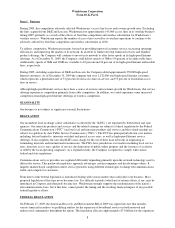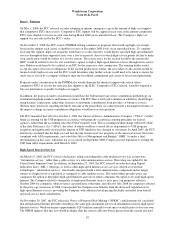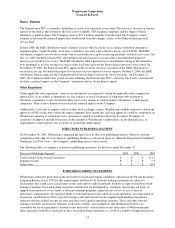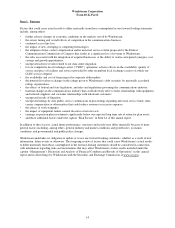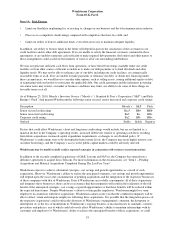Windstream 2009 Annual Report Download - page 85
Download and view the complete annual report
Please find page 85 of the 2009 Windstream annual report below. You can navigate through the pages in the report by either clicking on the pages listed below, or by using the keyword search tool below to find specific information within the annual report.
Windstream Corporation
Form 10-K, Part I
Item 1. Business
STATE REGULATION
Local and Intrastate Rate Regulation
Most states in which our ILEC subsidiaries operate provide alternatives to rate-of-return regulation for local and
intrastate services, either by law or PSC rules. We have elected alternative regulation for our ILEC subsidiaries in all
states except New York. We continue to evaluate alternative regulation options in New York where our ILEC
subsidiary remains subject to rate-of-return regulation.
Inter-carrier Compensation
On October 5, 2007, Verizon filed a complaint with the Ohio Public Utility Commission (“PUC”) alleging that the
Company’s intrastate access rates are excessive and should be reduced to the same levels charged by the largest ILECs
in Ohio, or in the alternative, to the Company’s interstate access rate levels. If the Ohio PUC were to grant Verizon’s
request and require the Company to implement the large ILEC rate structure, the Company would incur a reduction in
annual revenues of up to $7.6 million. This estimate assumes the Company would be allowed to implement retail rate
increases simultaneously with the access rate reductions similar to the plan adopted by the PUC for the larger Ohio
ILEC access rate reductions. The Ohio PUC has not acted upon requests by other parties for the Company and other
similar sized ILECs in Ohio to reduce their intrastate access rates.
On December 5, 2007 and February 22, 2008, Verizon filed complaints with the Kentucky PSC and the Georgia PSC
very similar to the complaint filed in Ohio. In these cases, Verizon also alleges that the Company’s intrastate access
rates are excessive and should be reduced to the level currently charged by AT&T (formerly BellSouth).
The Company requested that the Ohio PUC, the Kentucky PSC and the Georgia PSC deny Verizon’s requested relief
based in part on the fact that the Company’s intrastate access rates are just and reasonable and on the current efforts to
reform inter-carrier compensation comprehensively at the federal level, as previously explained.
On March 19, 2009, AT&T filed a complaint with the Pennsylvania PUC alleging that the Company’s intrastate access
rates are not just and reasonable and should be reduced to the Company’s interstate access rate levels.
On November 23, 2009, Sprint requested that the North Carolina Utilities Commission reduce the Company’s access
rates to a cost-basis or, in the alternative, to the Company’s interstate access rate levels.
The Company will request that the Pennsylvania PUC and the North Carolina Utilities Commission deny AT&T’s and
Sprint’s requested relief based in part on the fact that the Company’s intrastate access rates are just and reasonable and
on the current efforts to reform inter-carrier compensation comprehensively at the federal level, as previously
explained.
At this time, the Company cannot estimate the financial impact of any PSC decision due to the various options the PSC
could consider if it ruled in Complainant’s favor.
Universal Service
We recognize revenue from state universal service funds in a limited number of states in which we operate. In 2009,
Windstream recognized $131.1 million in state universal service revenue. These payments are intended to provide
additional support, beyond the federal universal service receipts, for the high cost of operating in rural markets. For the
year ended December 31, 2009, Windstream received approximately $97.8 million from the Texas USF. There are two
high-cost programs of the Texas USF, one for large companies and another for small companies. In 2009, Windstream
received $85.5 million from the large company program and $12.3 million from the small company program. The
purpose of the Texas USF is to assist telecommunications providers in providing basic local telecommunications
services at reasonable rates to customers in high cost rural areas and to qualifying low-income and disabled customers.
By order of the Texas PUC, the Texas USF distributes support to eligible carriers serving areas identified as high cost,
on a per-line basis. Texas USF support payments are based on the number of actual lines in service and therefore are
subject to reductions when customers discontinue service or migrate to a competitive carrier. All customers of
telecommunications services in Texas contribute to the Texas USF through the payment of a monthly surcharge by
their customers.
12








